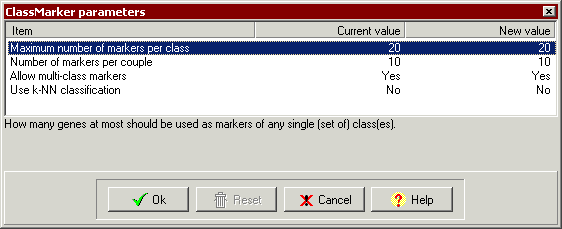|
The "Ok" button means that you
will run the algorithm with the parameter values given in the "New
value" column.
The "Reset" button will set all
the values in the "New value" column to those in the
"Current value" column, invalidating all changes you
made. The button is enabled only when you change at least one value.
The "Cancel" button will return
to the previous screen.
A short explanatory text on the currently selected
option is shown in the space immediately above (Macintosh) or below (PC,
shown in the above figure) the list of parameters. Press Return or double-click
the line to change the value of a parameter. If a parameter changes, the
new value appear in the "New value column", and the field
is marked by a red background (Macintosh) or a red arrow (PC).
The parameters have the following meaning.
a) Maximum number of markers per class
This number specifies the highest number of discriminant genes that
will be taken into account for any class during the analysis. In case
the multi-class analysis is selected (see below), this comprises markers
for all class distinctions of a class.
b) Number of markers per couple
In a multi-class analysis, this specifies the maximum number of additional
markers selected to distinguish among samples in a pair of classes .
c) Allow multi-class markers
When selected (Yes), ClassMarker is allowed to take into account marker
genes that discriminate between a pair of classes against the
others. This allows e.g. for detection of genes that behave significantly
differently in a pair of diseases, such as two closely related cancers.
If not selected (No), ClassMarker will only identify marker genes that
discriminate a sample class against all the others.
d) Use k-NN classification
In the analysis, use the k-Nearest-Neighbours classification method
instead of voting. Note that with k-NN, multi-class classification is
impossible and the parameters b) and c) are ignored.
|
